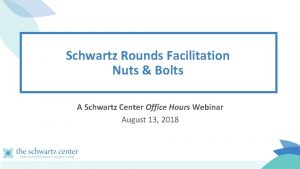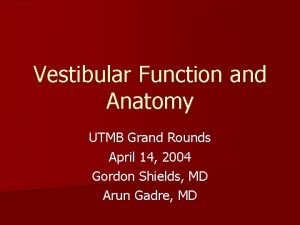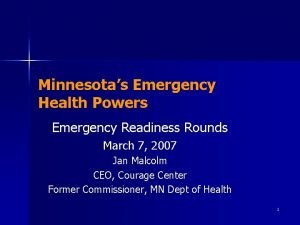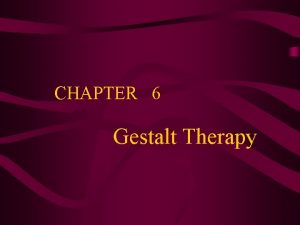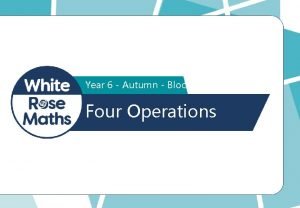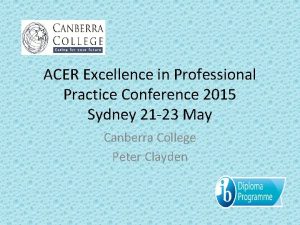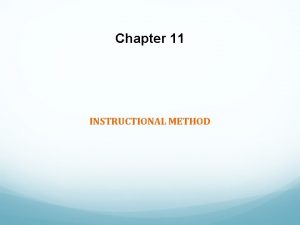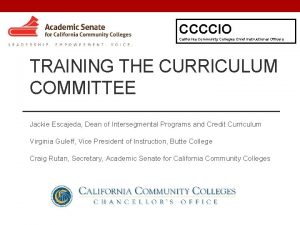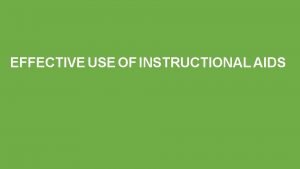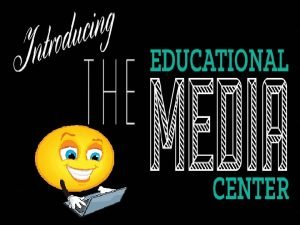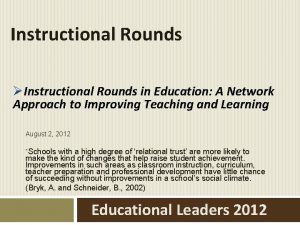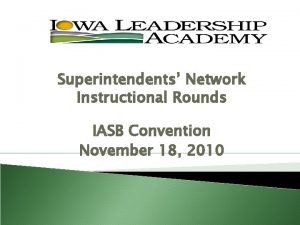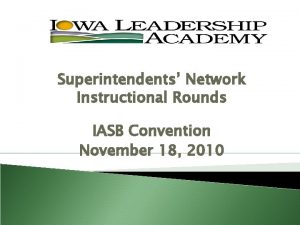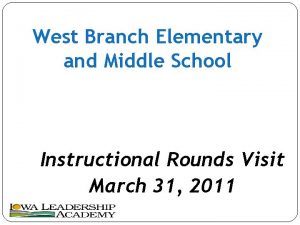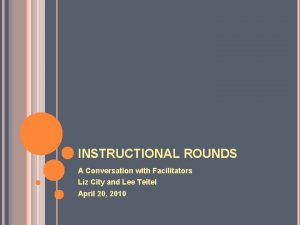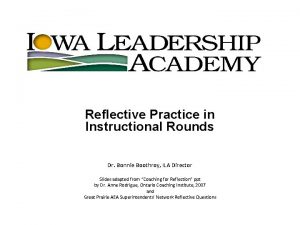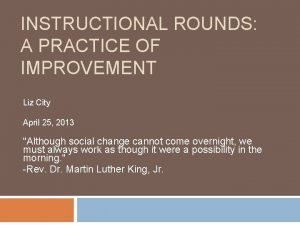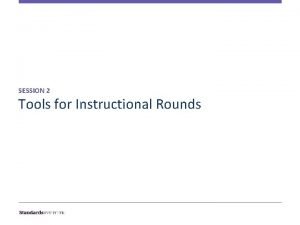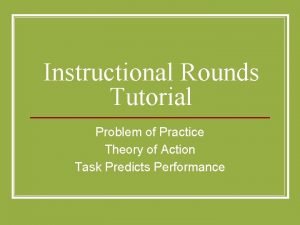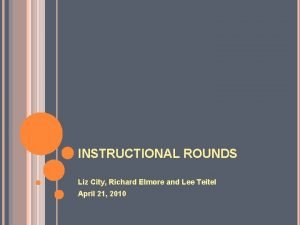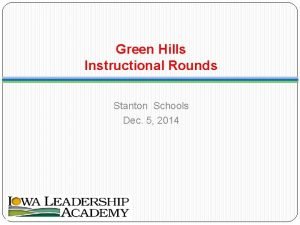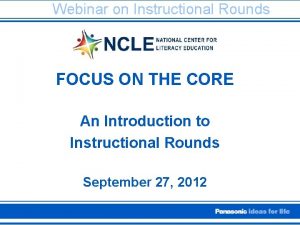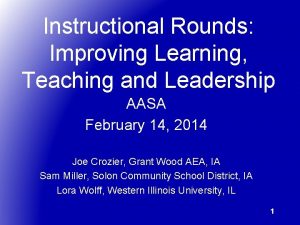Superintendents Network Instructional Rounds ICPEA April 19 2011






















- Slides: 22

Superintendents’ Network Instructional Rounds ICPEA April 19, 2011

Sponsors: Ø AEA system Ø School Administrators of Iowa Collaborative Partners: ØIowa Association of School Boards ØDepartment of Education ØHigher Education ØIowa State Education Association

Iowa’s National Recognition Only state with statewide “network of networks”

Statewide Participation Ø 115 Superintendents Ø 16 AEA Leaders Ø 2 Department of Education Representatives Ø 5 Professional Organization Representatives (SAI, IASB, ISEA) Ø 1 Higher Education Representative

The End: Improving Learning for All The Means: Instructional Rounds Process Network Structure 5

“I believe that it is essential that senior leaders first make deep changes in themselves before they expect changes in others. ” - Dennis Sparks Executive Director National Staff Development Council 6

Real Learning Requires Safety Psychological safety: “the collective belief within a work unit that members can question existing practices and admit mistakes without suffering ridicule or punishments. ” - Tucker, Nembhard, Edmondson 7

Goals of Instructional Rounds Ø Build skills of network members by coming to a common understanding or effective practice and how to support it. Ø Support instructional improvement at the host school by sharing what the network learns and by building skills at the local level.

An Instructional Rounds Network • • Is A learning community A method to examine the system A method to analyze student learning and student tasks An in-depth analysis of the instructional core observed in classrooms A process A way for network members to objectively describe teaching and learning Developing, through shared experiences in real classrooms, a common understanding of effective teaching practice and how to support it Collaboration to create coherence around instructional improvement at scale • • Is Not Learning in isolation A method to evaluate teachers and principals An instructional audit to determine if teachers are engaging in a specific practice A “walkthrough” A program A way for network members to learn supervision skills Reading about or listening to someone describe effective teaching practice and how to support it Working alone to “figure it out” for one’s own system 9

An Instructional Rounds Visit An Inquiry Process A Disciplined Practice Components: Ø Host identifies Ø Theory of Action Ø Problem of Practice Ø Focusing Questions Ø Network conducts classroom observations Ø Network debriefs generates questions or suggestions for Next Level of Work Ø Host and network follow-up

The Instructional Core CONTENT TEACHER STUDENT The relationship between the teacher and the student in the presence of content 11

Learning a New Way to Observe Ø Descriptive Ø Non-evaluative Ø Focus on all three elements of the instructional core 12

Comparison of Rounds and Walkthroughs Rounds • Addresses a problem of practice • Descriptive-analyticpredictive mode • Develops common norms of practice • Part of a broader improvement strategy • Builds a theory of action Walk-throughs • Checks for implementation of district programs • Normative mode • Assesses presenceabsence of practices • Evaluative 13

14

Benefits to superintendent Network Participation: Ø Enhances skills for leading district instructional improvement Ø Deepens knowledge of instruction and student learning in the district Ø Provides evidence, not assumptions, regarding instruction and student learning Ø Contributes to Individual Professional Development Plan Ø Models collaborative learning Ø Provides collegial network focused on teaching and learning Ø Provides structure to work closely with leadership team on improvement of student learning

What superintendents are saying… Ø I am skilled at using evidence to discuss and analyze observation data. 87. 5% Ø I learn better ways to improve instruction in my district by working with others from outside my district. 82% Ø I am learning what I should do differently, in my role as superintendent, as a result of what I’ve seen in classrooms. 77. 8%

Benefits to district Participation provides: Ø Insight to learning at the classroom level Ø Insight to learning and instructional trends across a building or district level Ø Considerations for “next level of work” Ø Opportunity for frequent superintendent-board conversation about student learning

Systems, not individuals, must steward the core. “If you haven’t organized every part of the system to relentlessly focus on and support the core, the best you’re going to realize is some learning for some students, and it will often be in spite of the system, not because of it. ” - Curtis and City

“We understand each others’ struggles better. We respect each others’ work more. We see ‘the work’ as ours and not ‘mine’ as a result of our network. ” 19

“I do a lot to keep on growing, but this network has been the strongest influence on my evolution as a district leader. When I’m with the network, I can be more vulnerable and more open to learning. ” Bob Villonova - Connecticut Supt of the Year 20

Improving Schools “We learn the work by doing the work. Instructional improvement is the work. We do everything else to support the work. ” Richard Elmore

Questions? Contact: Ø AEA Chief Administrators Ø Bonnie Boothroy, bboothroy@sai-iowa. org School Administrators of Iowa Director, Iowa Leadership Academy
 Richard elmore harvard
Richard elmore harvard New york state county highway superintendents association
New york state county highway superintendents association Pada tanggal 1 april 2011 cv seneng makmur
Pada tanggal 1 april 2011 cv seneng makmur Maintenance rounds
Maintenance rounds Red, white & blue bite size rounds tortilla chips
Red, white & blue bite size rounds tortilla chips Rounds and fillets are usually dimensioned using
Rounds and fillets are usually dimensioned using Schwartz rounds facilitator training
Schwartz rounds facilitator training Utmb grand rounds
Utmb grand rounds Anatomy of a bullet
Anatomy of a bullet Readiness rounds
Readiness rounds 5 layers of neurosis gestalt
5 layers of neurosis gestalt Sam rounds
Sam rounds What does 75 round to
What does 75 round to Duke medicine grand rounds
Duke medicine grand rounds A is an odd number which rounds to 100 000
A is an odd number which rounds to 100 000 Quality teaching rounds coding sheet
Quality teaching rounds coding sheet What do you call a stubborn angle
What do you call a stubborn angle Nursing grand rounds presentation example
Nursing grand rounds presentation example Instructional methods definition
Instructional methods definition Chief instructional officer
Chief instructional officer How to use chalkboard effectively
How to use chalkboard effectively Instructional materials from the media center
Instructional materials from the media center Instructional designer anzio
Instructional designer anzio






